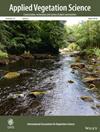Transient shifts in composition of degraded temperate native grassland following grazing exclusion
Abstract
Questions
Globally, grassy ecosystems are threatened and are still declining in extent in many areas. Improving the management of degraded native temperate grasslands that are grazed by livestock is important to the conservation of this critically endangered ecosystem. Questions remain about the role of grazing in the management of such grasslands, particularly in the face of climate change and given the sensitivity of these systems to inter-annual rainfall variability. Here, we investigate the effect of livestock exclusion on grassland composition.
Location
Temperate grassland, Victoria, Australia.
Methods
Over 9 years (2009–2017), we monitored plant functional groups in plots open-to-grazing or ungrazed exclusion plots within five fields of degraded native temperate grassland on private land.
Results
In the years after grazing had been excluded, we found significant differences in cover between grazed and ungrazed plots for some functional groups (e.g. native perennial graminoids) in some years, but we did not observe long-term divergence in cover or composition of the treatments. At the final monitoring point there were no significant differences in native or exotic species richness between the grazed and ungrazed plots. We show that the years in which differences were observed correspond with the 2010–2011 La Niña high-rainfall event, suggesting that grazing exclusion effects are mediated by rainfall, and are likely to be evident only under certain conditions.
Conclusion
In grassy ecosystems already degraded by long-term grazing, excluding grazing has limited potential to shift plant species composition in favour of native dominance. Such grasslands may persist in the medium term in a stable but degraded state with or without continued light to moderate livestock grazing pressure. Hence, managed livestock grazing need not be incompatible with the conservation of degraded temperate grasslands particularly where biomass management is important for the maintenance of faunal habitat. However, improving the function and diversity of these degraded grasslands will seemingly require additional management, including seed addition and experimentation with alternative disturbance regimes.


 求助内容:
求助内容: 应助结果提醒方式:
应助结果提醒方式:


